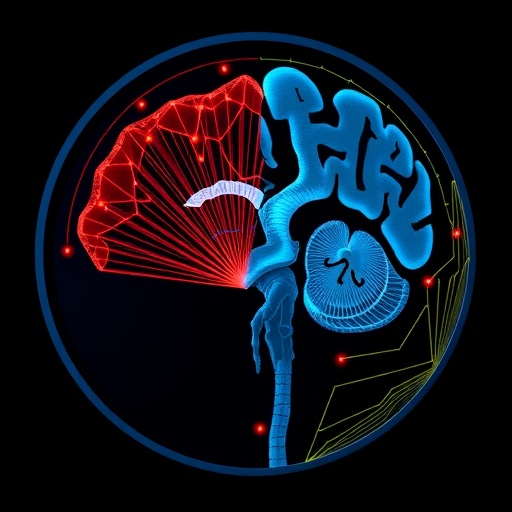In a groundbreaking study published in Genes and Immunity in 2025, researchers led by Xu, Guo, and Ning have delivered an unprecedented comprehensive analysis of heat shock proteins (HSPs) within glioma tumors, revealing intricate connections between these molecular chaperones and glioma-associated myeloid cells. This pioneering work illuminates new pathways in understanding glioma biology and opens promising avenues for therapeutic intervention against this devastating brain cancer.
Heat shock proteins, long recognized for their role in protecting cells from stress by facilitating proper protein folding and preventing aggregation, have increasingly been implicated in the complex tumor microenvironment. Gliomas, which are among the most malignant and treatment-resistant forms of brain cancer, have posed significant challenges for clinicians and researchers alike. This study marks a pivotal expansion in our understanding by integrating the role of HSPs within the tumor-immune cell interplay, particularly focusing on myeloid lineage cells residing in the glioma niche.
The intricate microenvironment of gliomas harbors various immune cell subsets, prominently including myeloid-derived suppressor cells (MDSCs) and tumor-associated macrophages (TAMs), which are known to contribute to the immunosuppressive and pro-tumorigenic milieu. Xu and colleagues undertook a systematic exploration of the expression profiles, functional states, and interactive dynamics of HSPs to elucidate their relationship with glioma-associated myeloid populations. Their findings indicate a positive correlation between specific HSP family members and the prevalence and activation state of these myeloid subsets.
They utilized multi-omics approaches encompassing transcriptomic, proteomic, and spatial analyses to map the presence of HSPs in glioma tissues obtained from patient samples. By employing high-resolution single-cell sequencing, the team was able to dissect cellular heterogeneity within the tumor landscape, unveiling subsets of myeloid cells whose behavior and phenotype appear to be modulated by HSP expression patterns. This molecular crosstalk is hinted to facilitate tumor progression and immune escape, presenting an intricate survival mechanism exploited by glioma cells.
Moreover, the researchers demonstrated that certain heat shock proteins, especially members of the HSP70 and HSP90 families, are not only upregulated in glioma cells but are actively secreted into the tumor microenvironment. These extracellular HSPs interact with glioma-associated myeloid cells through pattern recognition receptors (PRRs), such as toll-like receptors (TLRs), triggering downstream signaling pathways that promote an immunosuppressive phenotype. These findings suggest that HSPs act as molecular mediators orchestrating the tumor-supportive functions of myeloid cells.
Importantly, the study also dissected the impact of HSP expression on glioma prognosis, revealing that elevated levels of certain HSPs correspond with poorer patient survival. This prognostic association underscores the clinical significance of targeting HSP-related pathways. Therapeutics aimed at disrupting HSP functions, or modulating their interaction with myeloid cells, could impair the tumor’s ability to harness immune cells for its benefit, potentially restoring anti-tumor immunity.
The functional analyses extend into experimental models, where inhibition of HSPs attenuated the immunosuppressive activity of glioma-associated myeloid cells and decreased tumor growth, validating the translational relevance of their observations. These preclinical findings bridge the gap between molecular insights and therapeutic applications, suggesting novel combinatorial approaches with existing immunotherapies.
Another compelling aspect of this research lies in deciphering how stress signals within the tumor milieu regulate the expression and release of HSPs. Tumor hypoxia, metabolic stress, and inflammatory cues synergistically upregulate HSPs, reinforcing the tumor’s adaptive capacity under hostile conditions. These insights provide a conceptual framework for understanding glioma resilience and adaptability, anchoring HSPs as key players in tumor homeostasis.
The spatial organization of HSP expression relative to immune cell infiltration also emerged as a crucial factor in the tumor microenvironment’s complexity. Spatial transcriptomics revealed localized hotspots of HSP-high glioma cells co-localizing with clusters of immunosuppressive myeloid cells. This physical proximity hints at intimate cellular dialogue facilitated through HSP-driven signaling circuits, fostering tumor progression at a micro-anatomical level.
Xu and colleagues further delved into the epigenetic regulation governing HSP expression in gliomas, identifying chromatin remodeling events and non-coding RNA networks that fine-tune the transcriptional programs of HSPs within distinct tumor compartments. This regulatory layer adds complexity but also highlights potential epigenetic intervention points for future therapies.
The implications of this research extend beyond gliomas. Given the ubiquitous expression and functional conservation of heat shock proteins across cancers, the mechanistic insights into HSP-mediated modulation of tumor-associated immune cells could inform therapeutic strategies in other solid tumors marked by immunosuppressive microenvironments. This elevates the study’s significance, positioning it at the forefront of tumor immunology and molecular oncology.
In summary, this comprehensive analysis unravels a previously underappreciated axis of tumor biology, where heat shock proteins emerge as central mediators linking glioma cells and myeloid immune components. The findings advocate for intensified research into HSP-targeted therapies and their integration into multimodal treatment regimens aiming to overcome glioma’s notorious therapeutic resistance.
As the research community continues to dissect the molecular intricacies of the glioma microenvironment, studies like this illuminate the path toward precision oncology. Targeting the HSP-myeloid cell interactions holds promise not only for mitigating immunosuppression but also for reinstating effective immune surveillance, potentially improving the dismal prognosis associated with gliomas.
This landmark study underscores the necessity of viewing gliomas through a holistic lens that incorporates tumor biology, immune dynamics, and molecular stress responses. Through such integrated perspectives, the future of glioma treatment becomes increasingly hopeful, guided by molecular insights and innovative therapeutic possibilities.
Subject of Research: Heat shock proteins and their role in modulating glioma-associated myeloid cells within the glioma tumor microenvironment.
Article Title: Comprehensive analysis of heat shock proteins in glioma revealed the association with glioma-associated myeloid cells.
Article References:
Xu, J., Guo, Y., Ning, W. et al. Comprehensive analysis of heat shock proteins in glioma revealed the association with glioma-associated myeloid cells. Genes Immun (2025). https://doi.org/10.1038/s41435-025-00327-5
Image Credits: AI Generated
DOI: https://doi.org/10.1038/s41435-025-00327-5
Tags: brain cancer treatment challengesglioma research advancementsglioma-associated myeloid cellsheat shock proteins in gliomasimmunosuppression in glioma microenvironmentinteractions between immune cells and tumorsmolecular chaperones and glioma biologymyeloid-derived suppressor cells in brain cancerprotein folding and cancertherapeutic interventions for gliomatumor microenvironment and immune cellstumor-associated macrophages in glioma





